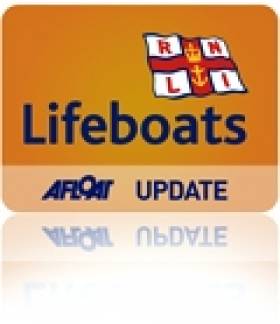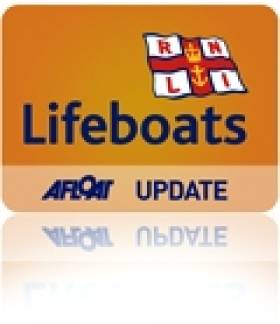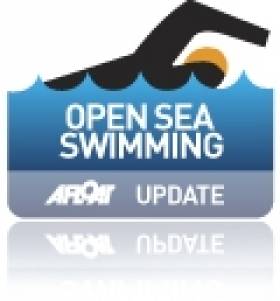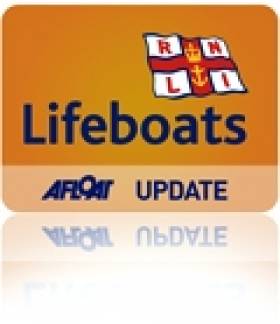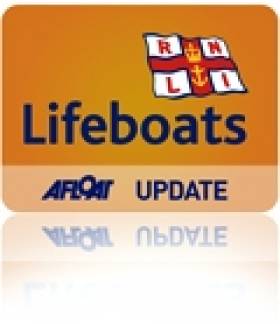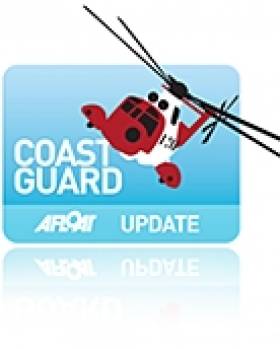Displaying items by tag: RNLI
Bundoran RNLI Lifeboat Assists in Unusual Call
Commenting after the call out, deputy launching authority Patrick O'Doherty said, "It was a very unusual call out for the crew, but this is why we train for every eventually. The coastguard raised the alarm and the lifeboat was tasked to assist in the operation by providing on scene safety as electricity and water are a very dangerous combination. It is important to follow safety advice when taking to the water. Water safety information is available from the RNLI's website, www.rnli.ie
RNLI Donaghadee and Bangor Lifeboats Launch to Rescue Five People
Belfast Coastguard received the initial 999 telephone call for help from crew onboard a third leisure fishing vessel which was in the area. Reports indicate that a 33ft leisure fishing boat and a 35ft leisure fishing boat had both experienced engine failure and were adrift close to Belfast shipping routes.
Within minutes of the rescue pagers being activated, volunteer crews had launched Donaghadee and Bangor Lifeboats and were proceeding at full speed towards the disabled vessels.
The two stricken boats were located 1 mile south of the Salt Jetty.
Relative calm on scene weather conditions allowed crew from RNLI Bangor Lifeboat to rig a tow line with the smaller of the two boats; she was then taken under tow to the safety of Carrickfergus Harbour.
Thankfully crew onboard the larger vessel were able to make engine repairs while RNLI Donaghadee Lifeboat stood close by. The vessel was then escorted to the safety of Carrickfergus Harbour.
RNLI volunteer station officer Kevin Baird used these rescues to highlight a RNLI safety message when he said. We always urge everyone going afloat to make sure their engine and fuel systems and are well maintained and in good working order. Engine failure close to shore and commercial shipping routes could lead to a life threatening situation'. He added 'We're happy that everyone onboard both vessels are now safely ashore'.
45 swimmers take to the water for Ballycotton RNLI lifeboat
Plan A on Friday evening last was to swim from the Ballycotton RNLI lifeboat slip, out around Ballycotton lighthouse and back to the lifeboat slip. The August weather had other ideas. The event organisers arrived in Ballycotton at 3:30pm, reviewed the conditions in Ballycotton Bay and put Plan B into action. Three buoys were placed in the Bay and the 45 swimmers had to swim around these to complete the 3.5 km swim.

The swim was organised by the Munster Open Water Swimming Organisation and they travelled from as far as Limerick in the west to Waterford in the east and places in between. The swimmers ranged in age from 13 to 65 years. They were started in five different groups, at five minute intervals, the
slower starting first and the fastest in the last group. By doing this the field would have tightened up towards the end of the swim. Each group was accompanied by kayakers for the entire swim. The organisers had two ribs in the area also. The Ballycotton RNLI all weather lifeboat, Austin Lidbury,
kept careful watch over the swimmers in the middle of Ballycotton Bay and their boarding boat, with two lifeboat crewmembers aboard, moved throughout the entire route.
There was a sprint for the finish between two swimmers, who completed the course in 50 minutes. The camaraderie among the group was infectious and the many onlookers felt involved. Having swum the 3.5 km course they then waited on the Ballycotton lifeboat slip for the other contestants to finish.
One of the organisers, Carol Cashell, explained that all entrants had to have swum a 3 km open water competition previously to qualify. She related that the swimmers enjoy the freedom of swimming long distances in the open water. Carol confirmed 32 did this swim last year, when they successfully
swam around Ballycotton lighthouse, 6 have swum the English Channel, 6 have done the Straits of Gibraltar and 2 have swum around Manhattan Island in the US. When asked about the weather conditions and how they affected the swimmers she explained that they don't particularly like the sunny days as this blinds them. They would have been happy enough with the misty evening they were faced with. However, by the end of the swim the sun shone on this harty group.

This event was a fundraising effort for Ballycotton RNLI lifeboat. Initially an email was sent to 150 swimmers listed on the Sandycove mailing list. By the morning of the event, Friday 19 August, 45 swimmers, 14 kayakers and 2 ribs had volunteered their time and energy to help raise funds for our lifeboat service. Carol explained that the swimmers have done swims such as this for other lifeboat stations in Co. Cork, e.g. Courtmacsherry, Kinsale, Crosshaven. As a charity the RNLI appreciates
efforts such as this in support of their lifeboats which offers a free service to those in trouble at sea. When the swim was finished and all swimmers had safely completed the course they left with the promise that they would be back again next year.
Wicklow Lifeboat Tows Yacht to Safety After Rope Fouls Prop
The yacht with two persons onboard was taking part in a race along the Wicklow coast when the mast and rigging was damaged, the skipper attempted to use the engine but a rope had fouled the propeller leaving the vessel drifting helplessly.
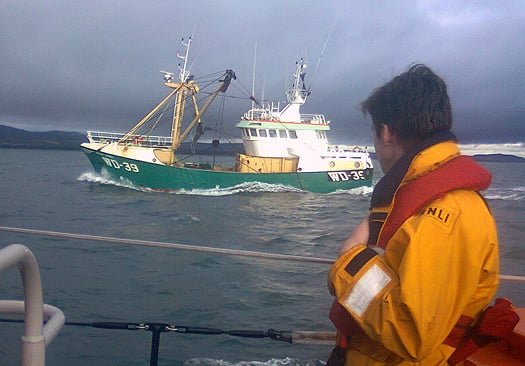
Wicklow lifeboat tows the yacht to safety last night
The lifeboat crew under the command of Coxswain Ciaran Doyle located the stricken yacht about one mile east of the North Arklow buoy and was alongside less than 30 minutes after launching. Once a towline had been rigged by the lifeboat crew the casualty was taken under tow to Wicklow harbour. The yacht was secured alongside the south quay at 7pm and the two sailors were landed safely ashore. This was the second incident the volunteer crew responded to over the weekend.
Lough Derg Lifeboat Investigates Reports of Unmanned Cruiser
At 17.05hrs Lough Derg RNLI Lifeboat launched with helm Eleanor Hooker, Peter Clarke and Ben Ronayne on board. As the lifeboat made its way to the casualty vessel, it was established that the skipper of the vessel, safe and unharmed, had been taken by a passing motor boat to Garrykennedy Harbour. It was noted that some boats, having seen the cruiser, were navigating the wrong side of the Mountaineer. The lifeboat took the skipper back to his vessel. The craft was not holed but had suffered damage to its props. With the boat's skipper and a lifeboat crew member on board, the vessel was taken off the rocks and towed to Williamstown Harbour, where it was tied up safely alongside at 18.40hrs. The lifeboat returned to station and were ready for service again at 19.00hrs.
Earlier today, at 10am Lough Derg RNLI lifeboat, Toshiba Wave Warrior, went to the assistance of 4 persons on board a 40ft cruiser that had run aground close to the mouth of the river in Terryglass Bay. The crew had hoisted their distress flag to draw attention to their dilemma.
At 10.45hrs on Sunday August 22, the crew of Lough Derg RNLI Lifeboat, helm Peter Clarke, Dom Sharkey and Ben Ronayne came across a vessel aground and flying her distess flag whilst out on exercise at the northern end of Lough Derg. They alerted Valentia Coast Guard that they were going to assist. Winds were westerly force 3 and visibility was very good. The vessel, which had been aground for two hours, had four crew, two of whom were in the water inspecting the hull. They were advised to get back onboard and to change into warm dry clothes. Having establishing that the boat was not holed, the lifeboat took her off the rocks and towed her to the safety of Portumna Castle Harbour, where she was tied up alongside at 11.20hrs. The lifeboat returned to station and was ready for service again at 12.57hrs
While it might be an exaggeration to say that all of the 21 crew members of Rambler 100 owe their lives to the Irish Search and Rescue service, there are certainly five people whose future prospects were greatly improved by the operation off the Fastnet Rock on August 15th. A lot of media focus has been on Coxswain Kieran Cotter and the crew of Baltimore Lifeboat as well as lifeboat mechanic Jerry Smith, whose dive boat, on charter to the media team of one of the competitors, was on hand to search and recover the five drifting crew. There is no question that this focus is appropriate. RNLI crews all over the UK and Ireland deserve the attention, not only because of their extraordinary voluntary dedication to the cause, but also because such publicity helps swell the coffers of the charity. The service could not operate without the generosity of the donors and incidents such as these help fill the blue boat-shaped boxes held by even more RNLI volunteers.

Saved: Ireland's Rescue Services Answered the Call of the capsized Supermaxi Rambler 100 off the Fastnet Rock. Photo: Team Phaedo
The dramatic stories and pictures dominating the media show the front line of a quite wonderful resource that is Search and Rescue in Ireland today. Baltimore Lifeboat was at the coal face of an intricate network of operations, triggered by the crew's EPIRBs. Irish Coast Guard radio officers in Valentia responded almost immediately tasking the rescue resources, working the phones and computers to confirm that this was not an accidentally triggered EPIRB, contacting RORC HQ, determining search patterns and relaying the information to the scene. It was the backroom contacts between RORC and the Coast Guard in endeavouring to contact Rambler 100 using satellite phones that confirmed the possibility of a catastrophic incident involving the Supermaxi. The subsequent tasking of the Shannon and Waterford based Sikorsky helicopters led to the medevac of crew member Wendy Touton and timely treatment of her hypothermic condition, initially by the on-board paramedics and later at Tralee General hospital. And Coast Guard involvement didn't end with the successful rescue – the shoreside operation to provide food and shelter in Baltimore was coordinated by Coast Guard personnel and the salvage operation of the hull of Rambler 100 was overseen by the Irish Coast Guard.

Rambler crew are recovered from the water after a SAR operation by the Irish Coastguard Photo: Team Phaedo. More photos here.
That Ireland has probably one of the best Search and Rescue services in the world goes back to the campaign initiated in 1988 by Joan McGinley, following the death, within sight of land of Donegal fisherman John Oglesby, whose leg was severed in a trawl winch. Eamon Doherty, the late former Garda Commissioner chaired the review group established in response to the campaign and his report led to the establishment of the Irish Marine Emergency Service, subsequently the Irish Coast Guard. Under the guidance of Director Capt Liam Kirwan, the new service moved quickly to become not only the central co-ordinating body for Search and Rescue, but developed its own resources, notably the helicopters, previously tasked in from Irish Air Corps and UK SAR.
Another element that will feature in the Rambler 100 incident is the Marine Casualty Investigation Board (MCIB), set up from recommendations arising from a review of the handling of investigations into marine casualties.
It might be thought that the incident is now closed, but there are many unanswered questions and the investigation will be looking at these and making recommendations that should improve safety in this sector. These questions will include EPIRB performance, liferaft deployment and grab bag usage, but perhaps the key issue yet to be determined is why the response from fellow competitors didn't appear to happen. Even if Channel 16 wasn't being actively monitored, and if not why not, shouldn't the Mayday set off by the Coast Guard have set off the DSC alerts on the radios of Rambler 100's fellow competitors? Had the incident occurred several hours later or earlier when Rambler 100 could have been up to 100 miles from the nearest land, when conditions worsened, we could be looking at much more serious consequences.
It is heartening to think that, in this small country of ours in troubled times, not only do we have a shining star in our search, rescue, recovery and restore system, involving professionals and volunteers cooperating for the greater good, we also have a system that determines the nature of incidents so that we can all learn from the experience.
And let us not forget those people and services, such as the Gardai, Navy, Army and the community of Baltimore who are outside the media spotlight who contributed to this happy ending.
Afloat's Latest Coastguard News
Afloat's Latest RNLI Lifeboat News
Afloat's Latest MCIB News
Seasick Sailors Rescued Off Channel Islands
BBC News reports that two seasick sailors and their yacht had to be towed to safety yesterday by the Alderney lifeboat in the Channel Islands.
The 12m yacht Astazou - which was returning to mainland England from Guernsey - had reported engine problems, and its crew were unable to sail due to severe seasickness.
RNLI Alderney launched the lifeboat Roy Barker I on Thursday at 7.45pm and was alongside the yacht within the hour. Yacht and crew were then towed to Braye Harbour before midnight.
DSC Alert Sends Rescuers Straight to Scene of Sinking Vessel
The digital selective calling (DSC) alert requesting immediate assistance was received at just after 8.15pm. Using AIS and DSC the vessel was located just off Runabay Head and identified as the Katoni. RNLI lifeboats from Redbay and Larne were sent to the scene whilst the police helicopter flew overhead. Ballycastle Coastguard Rescue Team were also sent to the scene to assist.
The area was thoroughly searched and no vessel was found. At just after 9.30pm a 999 call came in from one of the three crew to say although the vessel had been taking on water they had made it safely to shore.
Belfast Coastguard Watch Manager Alan Pritchard said;
"The crew of this vessel was extremely well prepared. They were wearing lifejackets, had a DSC radio and knew how to use it. Because of this they were able to call for immediate assistance and although they couldn't actually talk to us we knew where they were and that they needed help. They also had the presence of mind to let us know that they had reached the shore safely so we were able to call off the search."
Rambler 100 Crew Member 'Feels Lucky to be Alive'
An Australian crewmember on the stricken Rambler 100, which capsized in high winds during yesterday's Rolex Fastnet Race, has told reported that he feels "lucky to be alive".
Mike Motti was one of five crew who were separated from the yacht when it overturned near Fastnet Rock off the Cork coast.
He and his fellow crewmembers spent two hours adrift on a liferaft before they were rescued in foggy conditions which made the search all the more difficult.
“I’m feeling lucky to be alive, happy to be here and it’s great to see the local people here to greet us,” Motti told The Irish Times.
Fellow crewman Michael van Beuren said the yacht capsized within 30 seconds when its keel fin snapped in heavy seas.
All 21 crew were rescued from the yacht last night in an operation led by the Baltimore RNLI lifeboat and the Irish Coast Guard.
Free RNLI Lifejacket Clinic in Bangor
Anyone owning a lifejacket is invited to bring it along to the clinic and have it checked free of charge for safety.
During past lifejacket clinics, safety checks have revealed some astonishing potential life threatening maintenance issues.
This year Peter Bullick, a volunteer RNLI Sea Safety Officer and his dedicated team will be on hand to offer free lifejacket safety checks. They will also offer impartial advice on what maintenance action to take.


























